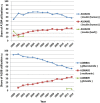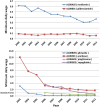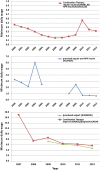Low utilisation of diabetes medicines in Iran, despite their affordability (2000-2012): a time-series and benchmarking study
- PMID: 25324322
- PMCID: PMC4202013
- DOI: 10.1136/bmjopen-2014-005859
Low utilisation of diabetes medicines in Iran, despite their affordability (2000-2012): a time-series and benchmarking study
Abstract
Objectives: Diabetes is a major public health concern worldwide, particularly in low-income and middle-income countries (LMICs). Limited data exist on the status of access to diabetes medicines in LMICs. We assessed the utilisation and affordability of diabetes medicines in Iran as a middle-income country.
Design: We used a retrospective time-series design (2000-2012) and assessed national diabetes medicines' utilisation using pharmaceuticals wholesale data.
Methods: We calculated defined daily dose consumptions per population days (DDDs/1000 inhabitants/day; DIDs) indicator. Findings were benchmarked with data from Organization for Economic Co-operation and Development (OECD) countries. We also employed Drug Utilization-90% (DU-90) method to compare DU-90s with the Essential Medicines List published by the WHO. We measured affordability using number of minimum daily wage required to purchase a treatment course for 1 month.
Results: Diabetes medicines' consumption increased from 4.47 to 33.54 DIDs. The benchmarking showed that medicines' utilisation in Iran in 2011 was only 54% of the median DIDs of 22 OECD countries. Oral hypoglycaemic agents consisted over 80% of use throughout the study period. Regular and isophane insulin (NPH), glibenclamide, metformin and gliclazide were the DU-90 drugs in 2012. Metformin, glibenclamide and regular/NPH insulin combination therapy were affordable throughout the study period (∼0.4, ∼0.1, ∼0.3 of minimum daily wage, respectively). While the affordability of novel insulin preparations improved over time, they were still unaffordable in 2012.
Conclusions: The utilisation of diabetes medicines was relatively low, perhaps due to underdiagnosis and inadequate management of patients with diabetes. This had occurred despite affordability of essential diabetes medicines in Iran. Appropriate policies are required to address the underutilisation of diabetes medicines in Iran.
Published by the BMJ Publishing Group Limited. For permission to use (where not already granted under a licence) please go to http://group.bmj.com/group/rights-licensing/permissions.
Figures






References
-
- Danaei G, Finucane MM, Lu Y, et al. . National, regional, and global trends in fasting plasma glucose and diabetes prevalence since 1980: systematic analysis of health examination surveys and epidemiological studies with 370 country-years and 2.7 million participants. Lancet 2011;378:31–40 - PubMed
-
- Whiting DR, Guariguata L, Weil C, et al. . IDF diabetes atlas: global estimates of the prevalence of diabetes for 2011 and 2030. Diabetes Res Clin Pract 2011;94:311–21 - PubMed
-
- Alldredge BK, Corelli RL, Ernst ME, et al. . Koda-Kimble & Young's applied therapeutics; the clinical use of drug. 10th edn. Lippincott Williams & Wilkins, 2012
-
- Nathan DM, Buse JB, Davidson MB, et al. . Medical management of hyperglycemia in type 2 diabetes: a consensus algorithm for the initiation and adjustment of therapy: a consensus statement of the American Diabetes Association and the European Association for the Study of Diabetes. Diabetes Care 2009;32:193–203 - PMC - PubMed
Publication types
MeSH terms
Substances
LinkOut - more resources
Full Text Sources
Other Literature Sources
Medical
